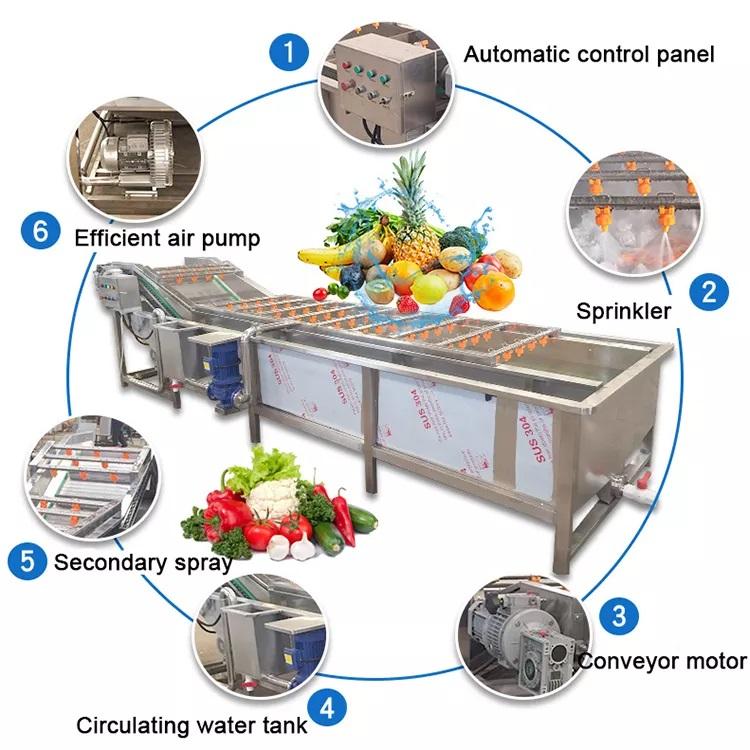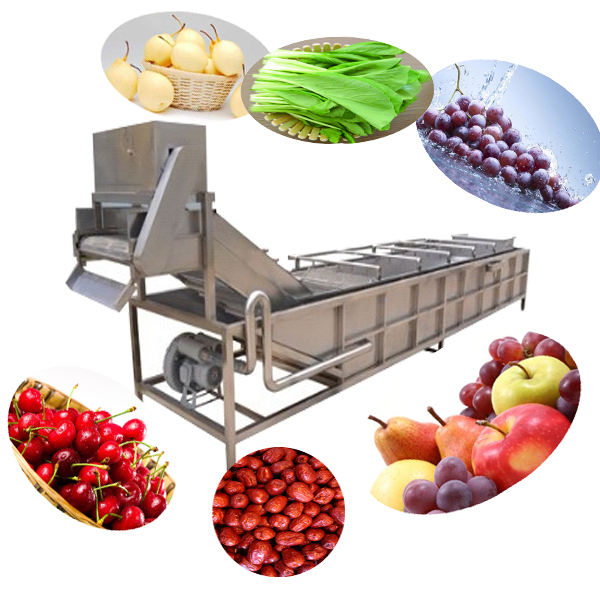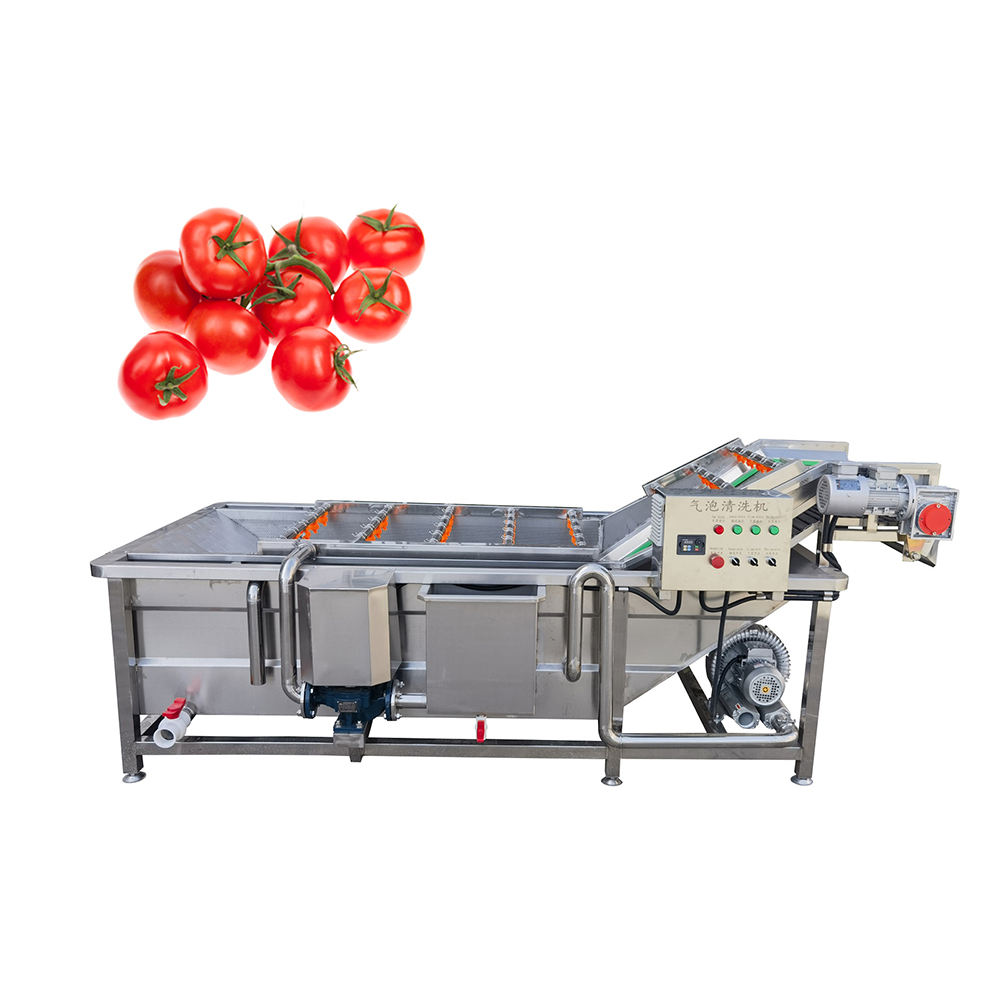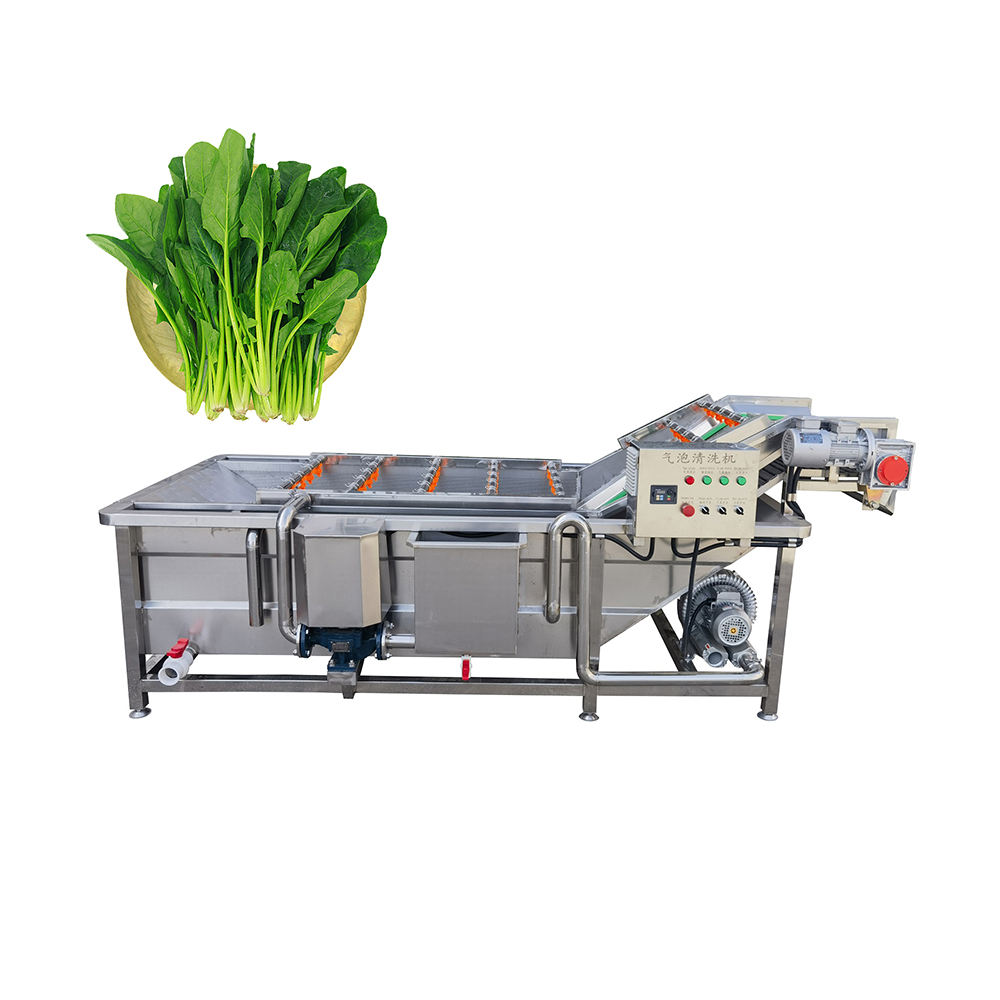1. Introdução
O bubble washing machine vegetable and fruit is an advanced piece of equipment designed for cleaning fresh produce using a combination of water immersion e air bubble agitation. This cleaning method is gentle, eficiente, and environmentally friendly, making it suitable for both delicate and firm produce.
As global consumers increasingly demand pronto para comer, pre-washed, and organic-certified produce, processors are upgrading from traditional manual washing to fully automated bubble washing systems.

1.1 Why Bubble Washing Matters in Modern Food Processing
- Conformidade com a segurança alimentar
Regulatory agencies such as the FDA, EU Commission, and CFIA require food producers to minimize microbial contamination, pesticide residues, and physical debris. - Product Quality Preservation
Bubble washing prevents bruising, discoloration, and nutrient loss, especially important for export markets. - Eficiência Operacional
Handles high volumes — from 500 kg/h for small plants para 10,000+ kg/h for large industrial facilities.
2. How a Bubble Washing Machine Works
UM bubble washing machine vegetable and fruit uses air bubbles generated by a blower to gently agitate produce in water, loosening dirt and contaminants.
2.1 The Process Flow
- Loading
Produce enters via a conveyor or manual hopper. - Water Tank Immersion
Fruits and vegetables are fully submerged. - Bubble Injection
Compressed air enters through perforated pipes, creating turbulence. - Dirt Separation
Heavy particles settle, light debris floats away. - Final Rinse
Clean water sprays remove any residual contaminants. - Descarga
A conveyor transfers produce to the next processing stage.
2.2 Key Science Behind Bubble Cleaning
- Hydrodynamic Effect: Bubbles create micro-currents that penetrate leaf folds.
- Surface Tension Reduction: Air bubbles reduce adhesion between dirt and produce skin.
- Oxygen Enrichment: Helps maintain freshness during cleaning.

3. Machine Design & Componentes
O bubble washing machine vegetable and fruit is engineered for durabilidade, higiene, e fácil limpeza.
| Componente | Função |
|---|---|
| Water Tank | Holds the washing solution. |
| Soprador de ar | Generates air for bubble production. |
| Mesh Conveyor | Moves produce through the cleaning zone. |
| Sediment Trap | Collects heavy debris. |
| Overflow Outlet | Removes floating impurities. |
| Rinse Section | Provides final clean water spray. |
| Painel de controle | Manages speed, air flow, and water circulation. |
Material: Aço inoxidável SUS304 (padrão), SUS316 for highly acidic produce.
4. Tabela de Parâmetros Técnicos
| Modelo | Capacidade (kg/hora) | Poder (kW) | Water Volume (L) | Dimensões (milímetros) | Peso (kg) | Material |
|---|---|---|---|---|---|---|
| DT-500 | 500 | 2.2 | 400 | 3000×1000×1300 | 280 | SUS304 |
| DT-1000 | 1000 | 3.7 | 600 | 4000×1200×1300 | 380 | SUS304 |
| DT-2000 | 2000 | 5.5 | 900 | 5000×1400×1350 | 520 | SUS304 |
| DT-3000 | 3000 | 7.5 | 1200 | 6000×1500×1400 | 650 | SUS304 |
| DT-5000 | 5000 | 11 | 1500 | 8000×1600×1450 | 950 | SUS304 |
5. Product Applications
- Leafy Greens: Lettuce, espinafre, kale, cabbage.
- Root Vegetables: Cenouras, batatas, radishes, beets.
- Fruits: Strawberries, grapes, maçãs, citrus.
- Ervas: Mint, manjericão, coriander.
- Medicinal Plants: Ginseng, chrysanthemum.

6. Benefits Over Other Washing Methods
| Recurso | Bubble Washing Machine | Spray Washing | Manual Washing |
|---|---|---|---|
| Damage to Produce | Muito baixo | Médio | Variável |
| Cleaning Thoroughness | Alto | Médio | Baixo |
| Exigência de mão -de -obra | Baixo | Médio | Alto |
| Water Use Efficiency | Alto | Médio | Baixo |
7. Guia de instalação
- Select Location – Level floor, near water & drainage.
- Install Utilities – Connect 3-phase power, water inlets, and drainage.
- Assembly – Attach blower, transportador, and rinse sections.
- Testing – Run with water only to check for leaks.
8. Operation Tips
- Pre-rinse heavily soiled produce before loading.
- Adjust bubble intensity for delicate items.
- Keep water temperature low to maintain freshness.
9. Maintenance Schedule
| Freqüência | Action |
|---|---|
| Diário | Drain & clean tank, rinse filters. |
| Semanalmente | Inspect blower and pump. |
| Mensal | Remove scaling, sanitize tank. |
| Yearly | Substitua as vedações, rolamentos. |
10. Água & Energy Saving Features
- Recirculation system reuses up to 80% of water.
- Automatic debris removal extends water life.
- Variable blower speed reduces power use.

11. Estudos de caso
Caso 1 – Leafy Green Processor in California
- Capacidade: 3000 kg/hora
- Resultado: Reduced labor by 70%, water use by 40%.
- ROI: Achieved in 14 meses.
Caso 2 – Berry Exporter in Chile
- Capacidade: 2000 kg/hora
- Resultado: Reduced bruising damage from 6% to under 1%.
12. Tendências de mercado
- Aumento da demanda por organic-certified washed produce.
- Increasing adoption in Asia-Pacific due to export markets.
- Integração com optical sorting machines.
13. Como escolher a máquina certa
- Capacity Requirements
- Product Type
- Disponibilidade de espaço
- Budget and ROI Goals
- Suporte pós-venda
14. Price Ranges
- Pequeno (500–1000 kg/h): $2,500–US$ 5.000
- Médio (2000–3000 kg/h): $6,000–$ 10.000
- Grande (5000+ kg/hora): $12,000–$20,000+
15. Extended FAQs
Q: Can it be used for seafood?
UM: Sim, with proper corrosion protection.
Q: Can it connect to peeling machines?
UM: Sim, commonly integrated in full processing lines.
Q: Is ozone disinfection available?
UM: Sim, as an optional add-on.
16. Troubleshooting Guide
| Problema | Possível causa | Solução |
|---|---|---|
| Weak bubbles | Low blower pressure | Check blower filter |
| Poor cleaning | Overloaded tank | Reduce feed rate |
| Water overflow | Blocked drain | Clean outlet |
17. Conclusão
UM bubble washing machine vegetable and fruit is not just a cleaning device — it’s a produtividade, qualidade, and safety investment. With the right model, you can increase throughput, melhorar a higiene, and reduce operational costs.
